In Vitro Assessment of Long-Term Fluoride Ion Release from Nanofluorapatite
Abstract
:1. Introduction
2. Materials and Methods
2.1. Fluorapatite Synthesis
2.2. Physicochemical Analysis of Fluorapatite
2.3. Release Analysis of F− Ions
2.4. Statistical Analysis
3. Results
3.1. Physicochemical Evaluation of Nanofluorapatite
3.2. The In Vitro Release of F− from Nanofluorapatite
4. Discussion
5. Conclusions
Author Contributions
Funding
Institutional Review Board Statement
Informed Consent Statement
Data Availability Statement
Acknowledgments
Conflicts of Interest
References
- Moothedath, M.; Moothedath, M.; Jairaj, B.A.; Suheel, H.; Baba, M.; Khateeb, S.U. Role of Nanotechnology in Dentistry: Systematic Review. J. Int. Soc. Prev. Community Dent. 2019, 9, 535–541. [Google Scholar] [PubMed]
- Abiodun-Solanke, I.M.F.; Ajayi, D.M.; Arigbede, A.O. Nanotechnology and its Application in Dentistry. Ann. Med. Health Sci. Res. 2014, 4, 171–177. [Google Scholar] [CrossRef] [PubMed] [Green Version]
- Bordea, I.R.; Candrea, S.; Alexescu, G.T.; Bran, S.; Băciu, M.; Băciu, G.; Lucaciu, O.; Dinu, C.M.; Todea, D.A. Nano-hydroxyapatite use in dentistry: A systematic review. Drug Metab. Rev. 2020, 52, 319–332. [Google Scholar] [CrossRef]
- Pepla, E.; Besharat, L.K.; Palaia, G.; Tenore, G.; Migliau, G. Nano-hydroxyapatite and its applications in preventive, restorative and regenerative dentistry: A review of literature. Ann. Stomatol. 2014, 5, 108–114. [Google Scholar] [CrossRef]
- Esteves-Oliveira, M.; Santos, N.M.; Meyer-Lueckel, H.; Wierichs, R.J.; Rodrigues, J.A. Caries-preventive effect of anti-erosive and nano-hydroxyapatite-containing toothpastes in vitro. Clin. Oral Investig. 2017, 21, 291–300. [Google Scholar] [CrossRef]
- Vano, M.; Derchi, G.; Barone, A.; Covani, U. Effectiveness of nano-hydroxyapatite toothpaste in reducing dentin hypersensitivity: A double-blind randomized controlled trial. Quintessence Int. 2014, 45, 703–711. [Google Scholar]
- Zakir, M.; Al Kheraif, A.A.A.; Asif, M.; Wong, I.F.S.L.; Rehman, I.U. A comparison of the mechanical properties of a modified silorane based dental composite with those of commercially available composite material. Dent. Mater. 2013, 29, 53–59. [Google Scholar] [CrossRef]
- Cappare, P.; Tete, G.; Sberna, M.T.; Panina-Bordignon, P. The Emerging Role of Stem Cells in Regenerative Dentistry. Curr. Gene Ther. 2020, 20, 259–268. [Google Scholar] [CrossRef] [PubMed]
- Cattoni, F.; Tete, G.; Calloni, A.M.; Manazza, F.; Gastaldi, G.; Cappare, P. Milled versus moulded mock-ups based on the superimposition of 3D meshes from digital oral impressions: A comparative in vitro study in the aesthetic area. BMC Oral Health 2019, 19, 230. [Google Scholar] [CrossRef]
- Zhou, H.; Lee, J. Nanoscale hydroxyapatite particles for bone tissue engineering. Acta Biomater. 2011, 7, 2769–2781. [Google Scholar] [CrossRef] [PubMed]
- Lowe, B.; Hardy, J.G.; Walsh, L.J. Optimizing Nanohydroxyapatite Nanocomposites for Bone Tissue Engineering. ACS Omega 2020, 5, 1–9. [Google Scholar] [CrossRef] [PubMed]
- Habibovic, P.; Barrère, F.; Van Blitterswijk, C.A.; De Groot, K.; Layrolle, P. Biomimetic hydroxyapatite coating on metal implants. J. Am. Ceram. Soc. 2002, 85, 517–522. [Google Scholar] [CrossRef] [Green Version]
- Ripamonti, U.; Roden, L.C.; Renton, L.F. Osteoinductive hydroxyapatite-coated titanium implants. Biomaterials 2012, 33, 3813–3823. [Google Scholar] [CrossRef] [PubMed]
- Pajor, K.; Pajchel, L.; Kolmas, K. Hydroxyapatite and Fluorapatite in Conservative Dentistry and Oral Implantology—A Review. Materials 2019, 12, 2683. [Google Scholar] [CrossRef] [Green Version]
- Marycz, K.; Sobierajska, P.; Smieszek, A.; Maredziak, M.; Wiglusz, K.; Wiglusz, R.J. Li+ activated nanohydroxyapatite doped with Eu3+ ions enhances proliferative activity and viability of human stem progenitor cells of adipose tissue and olfactory ensheathing cells. Further perspective of nHAP:Li+, Eu3+ application in theranostics. Mater. Sci. Eng. C 2017, 78, 151–162. [Google Scholar] [CrossRef]
- Marycz, K.; Smieszek, A.; Targonska, S.; Walsh, S.A.; Szustakiewicz, K.; Wiglusz, R.J. Three dimensional (3D) printed polylactic acid with nano-hydroxyapatite doped with europium(III) ions (nHAp/PLLA@Eu3+) composite for osteochondral defect regeneration and theranostics. Mater. Sci. Eng. C 2020, 110, 110634. [Google Scholar] [CrossRef]
- Crespi, R.; Capparè, P.; Gherlone, E. Comparison of magnesium-enriched hydroxyapatite and porcine bone in human extraction socket healing: A histologic and histomorphometric evaluation. Int. J. Oral Maxillofac. Implants 2011, 26, 1057–1062. [Google Scholar] [PubMed]
- Nikčević, I.; Jokanović, V.; Mitrić, M.; Nedić, Z.; Makovec, D.; Uskoković, D. Mechanochemical synthesis of nanostructured fluorapatite/ fluorhydroxyapatite and carbonated fluorapatite/fluorhydroxyapatite. J. Solid State Chem. 2004, 177, 2565–2574. [Google Scholar] [CrossRef]
- Malhotra, A.; Habibovic, P. Calcium Phosphates and Angiogenesis: Implications and Advances for Bone Regeneration. Trends Biotechnol. 2016, 34, 983–992. [Google Scholar] [CrossRef] [Green Version]
- Sadat-Shojai, M.; Atai, M.; Nodehi, A.; Khanlar, L.N. Hydroxyapatite nanorods as novel fillers for improving the properties of dental adhesives: Synthesis and application. Dent. Mater. 2010, 26, 471–482. [Google Scholar] [CrossRef]
- Roy, M.; Bandyopadhyay, A.; Bose, S. Induction plasma sprayed nano hydroxyapatite coatings on titanium for orthopaedic and dental implants. Surf. Coat. Technol. 2011, 205, 2785–2792. [Google Scholar] [CrossRef] [Green Version]
- Yaberi, M.; Haghgoo, R. A comparative study of the effect of nanohydroxyapatite and eggshell on erosive lesions of the enamel of permanent teeth following soft drink exposure: A randomized clinical trial. J. Int. Oral Health 2018, 10, 176–179. [Google Scholar]
- Barandehfard, F.; Kianpour Rad, M.; Hosseinnia, A.; Khoshroo, K.; Tahriri, M.; Jazayeri, H.E.; Moharamzadeh, K.; Tayebi, L. The addition of synthesized hydroxyapatite and fluorapatite nanoparticles to a glass-ionomer cement for dental restoration and its effects on mechanical properties. Ceram. Int. 2016, 42, 17866–17875. [Google Scholar] [CrossRef] [Green Version]
- Moshaverinia, A.; Ansari, S.; Moshaverinia, M.; Roohpour, N.; Darr, J.A.; Rehman, I. Effects of incorporation of hydroxyapatite and fluoroapatite nanobioceramics into conventional glass ionomer cements (GIC). Acta Biomater. 2008, 4, 432–440. [Google Scholar] [CrossRef] [PubMed]
- Wei, M.; Evans, J.H. Synthesis and Characterization of Hydroxyapatite Nanoparticle. Malaysian J. Anal. Sci. 2017, 21, 136–148. [Google Scholar]
- Zofková, I.; Nemcikova, P.; Matucha, P. Trace elements and bone health. Clin. Chem. Lab. Med. 2013, 51, 1555–1561. [Google Scholar] [CrossRef] [PubMed]
- Harrison, J.; Melville, A.J.; Forsythe, J.S.; Muddle, B.C.; Trounson, A.O.; Gross, K.A.; Mollard, R. Sintered hydroxyfluorapatites—IV: The effect of fluoride substitutions upon colonisation of hydroxyapatites by mouse embryonic stem cells. Biomaterials 2004, 25, 4977–4986. [Google Scholar] [CrossRef]
- Wei, J.; Wang, J.; Shan, W.; Liu, X.; Ma, J.; Liu, C.; Fang, J.; Wei, S. Development of fluorapatite cement for dental enamel defects repair. J. Mater. Sci. Mater. Med. 2011, 22, 1607–1614. [Google Scholar] [CrossRef]
- Rošin-Grget, K.; Peroš, K.; Sutej, I.; Bašić, K. The cariostatic mechanisms of fluoride. Acta Med. Acad. 2013, 42, 1791. [Google Scholar] [CrossRef] [Green Version]
- Lynch, R.J.M.; Navada, R.; Walia, R. Low-levels of fluoride in plaque and saliva and their effects on the demineralisation and remineralisation of enamel; role of fluoride toothpastes. Int. Dent. J. 2004, 54, 304–309. [Google Scholar] [CrossRef]
- Turner, C.H.; Boivin, G.; Meunier, P.J. A mathematical model for fluoride uptake by the skeleton. Calcif. Tissue Int. 1993, 52, 130–138. [Google Scholar] [CrossRef] [PubMed]
- Kosior, P.; Dobrzyński, M.; Korczyński, M.; Herman, K.; Czajczyńska-Waszkiewicz, A.; Kowalczyk-Zając, M.; Piesiak-Pańczyszyn, D.; Fita, K.; Janeczek, M. Long-term release of fluoride from fissure sealants—In vitro study. J. Trace Elem. Med. Biol. 2017, 41, 107–110. [Google Scholar] [CrossRef] [PubMed]
- Hasan, A.M.H.R.; Sidhu, S.K.; Nicholson, J.W. Fluoride release and uptake in enhanced bioactivity glass ionomer cement (“glass carbomer™”) compared with conventional and resin-modified glass ionomer cements. J. Appl. Oral Sci. 2019, 27, e20180230. [Google Scholar] [CrossRef] [PubMed]
- Selimović-Dragaš, M.; Hasić-Branković, L.; Korać, F.; Đapo, N.; Huseinbegović, A.; Kobašlija, S.; Lekić, M.; Hatibović-Kofman, Š. In vitro fl uoride release from a different kind of conventional and resin modifi ed glass-ionomer cements. Bosn. J. Basic Med. Sci. 2013, 13, 197–202. [Google Scholar] [CrossRef]
- Carey, M.C. Focus on fluorides: Update on the use of fluoride for the prevention of dental caries. J. Evid. Based Dent. Pract. 2014, 14, 95–102. [Google Scholar] [CrossRef] [Green Version]
- Kosior, P.; Dobrzynski, M.; Zakrzewska, A.; Grosman, L.; Korczynski, M.; Blicharski, T.; Gutbier, M.; Watras, A.; Wiglusz, R.J. Preliminary In Vitro Study of Fluoride Release from Selected Ormocer Materials. Materials 2021, 14, 2244. [Google Scholar] [CrossRef]
- Malik, S.; Ahmed, M.A.; Choudhry, Z.; Mughal, N.; Amin, M.; Lone, M.A. Fluoride Release From Glass Ionomer Cement Containing Fluoroapatite And Hydroxyapatite. J. Ayub Med. Coll. Abbottabad 2018, 30, 198–202. [Google Scholar]
- Tiwari, S.; Nandlal, B. Comparative evaluation of fluoride release from hydroxyapatite incorporated and conventional glass ionomer cement: An in vitro ionomer study. J. Indian Soc. Pedod. Prev. Dent. 2012, 30, 284–287. [Google Scholar] [CrossRef]
- Sobierajska, P.; Wiglusz, R.J. Influence of the grain sizes on Stokes and anti-Stokes fluorescence in the Yb3+ and Tb3+ ions co-doped nanocrystalline fluorapatite. J. Alloys Compd. 2019, 785, 808–818. [Google Scholar] [CrossRef]
- Wang, Y.; Liu, X.; Fan, T.; Tan, Z.; Zhou, Z.; He, D. In vitro evaluation of hydroxyapatite coatings with (002) crystallographic texture deposited by micro-plasma spraying. Mater. Sci. Eng. C 2017, 75, 596–601. [Google Scholar] [CrossRef]
- Giacaman, R.A.; Munoz-Sandoval, C.; Neuhaus, K.W.; Fontana, M.; Chałas, R. Evidence-based strategies for the minimally invasive treatment of carious lesions: Review of the literature. Adv. Clin. Exp. Med. 2018, 27, 1009–1016. [Google Scholar] [CrossRef]
- Rathi, N.; Baid, R.; Baliga, S.; Thosar, N. Comparative evaluation ofNano-Hydroxyapatite preparation and Calcium Sucrose Phosphate on microhardness of deciduous teeth after iron drop exposure—An in-vitrostudy. J. Clin. Exp. Dent. 2017, 9, 579–583. [Google Scholar]
- Clark, D.R.; Czajka-Jakubowska, A.; Rick, C.; Liu, J.; Chang, S.; Clarkson, B.H. In vitro anti-caries effect of fluoridated hydroxyapatite-coated preformed metal crowns. Eur. Arch. Paediatr. Dent. 2013, 14, 253–258. [Google Scholar] [CrossRef] [PubMed] [Green Version]
- Lin, J.; Zhu, J.; Gu, X.; Wen, W.; Li, Q.; Fischer-Brandies, H.; Wang, H.; Mehl, C. Effects of incorporation of nano-fluorapatite or nano-fluorohydroxyapatite on a resin-modified glass ionomer cement. Acta Biomater. 2011, 7, 1346–1353. [Google Scholar] [CrossRef] [PubMed]
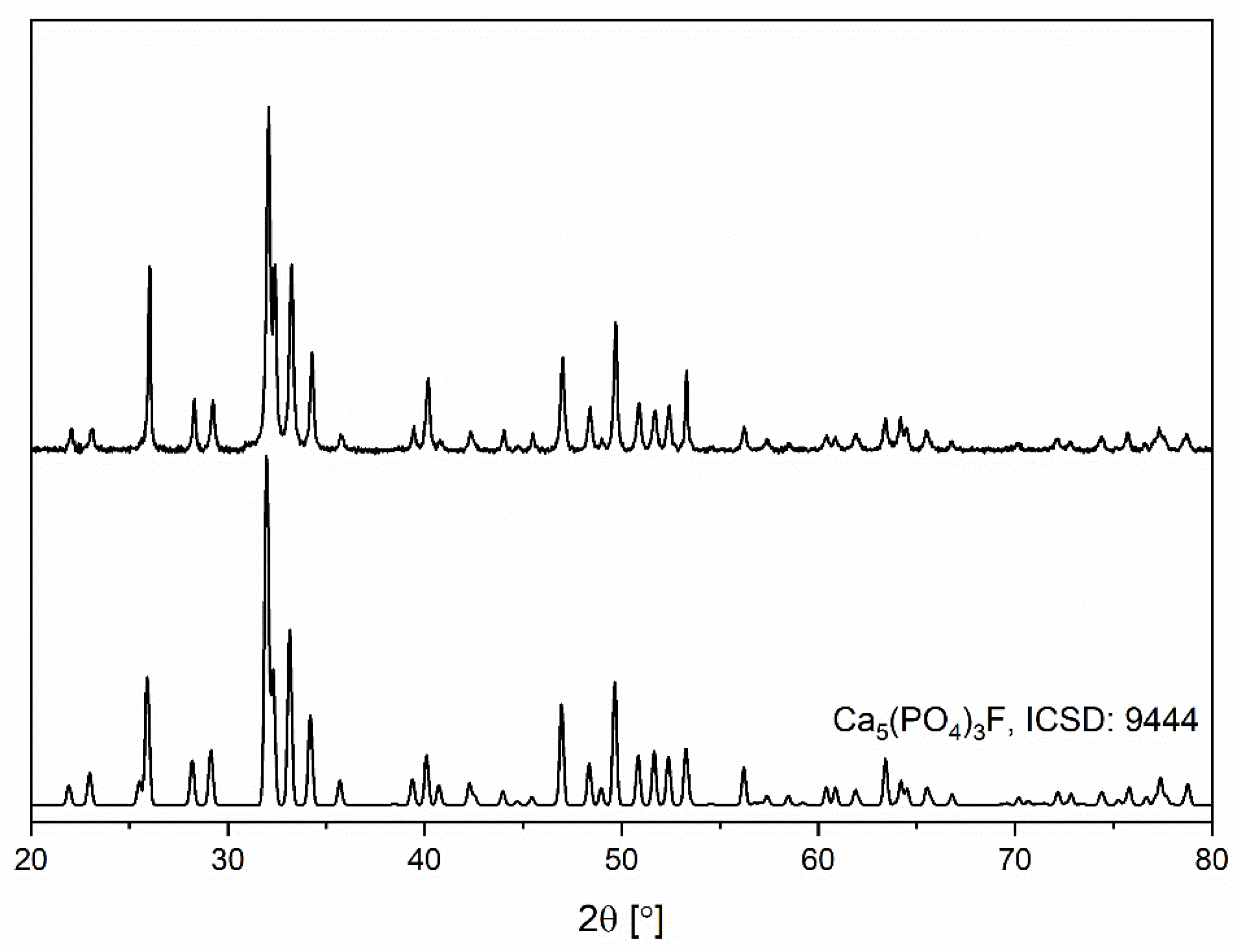
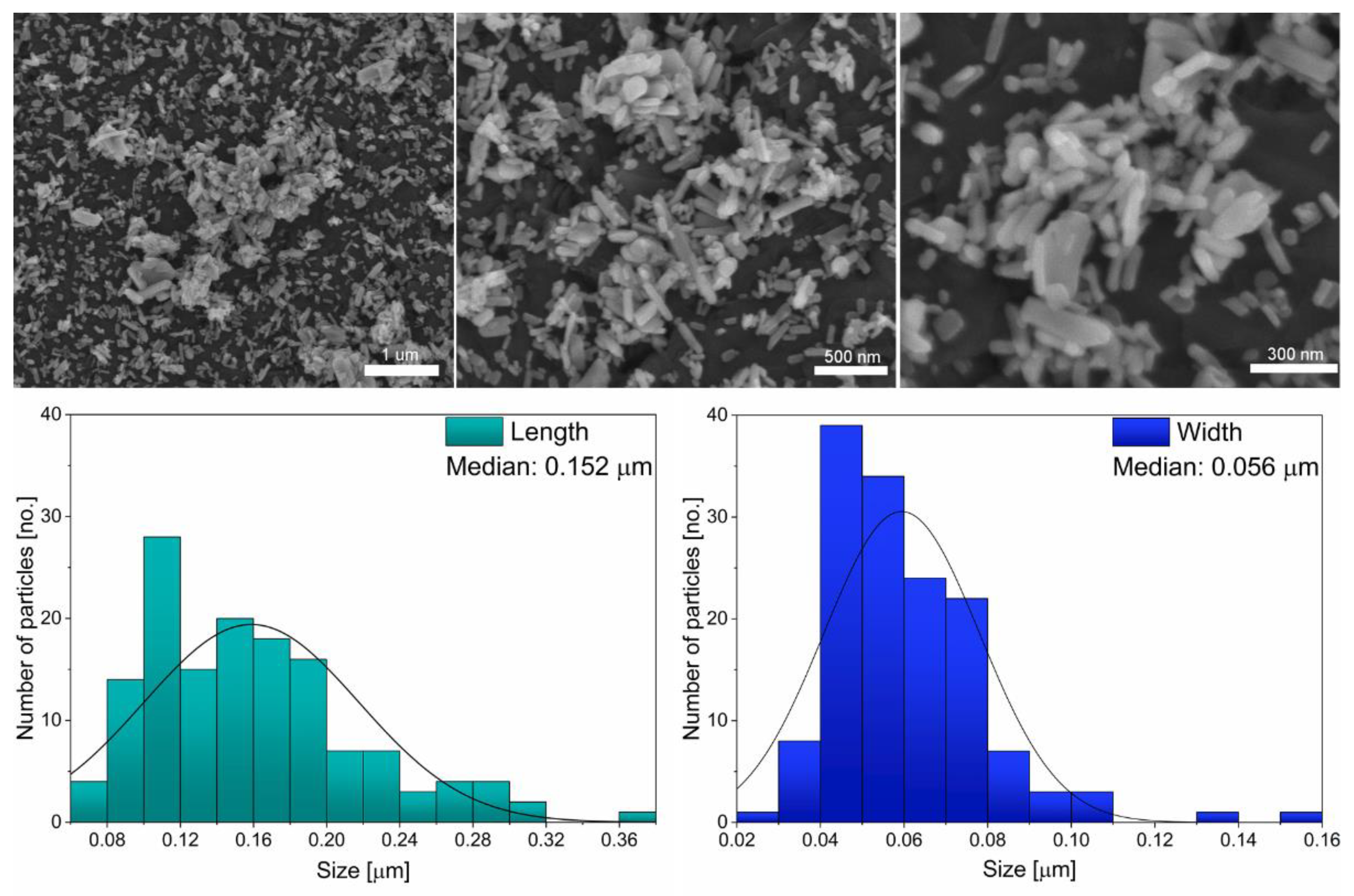
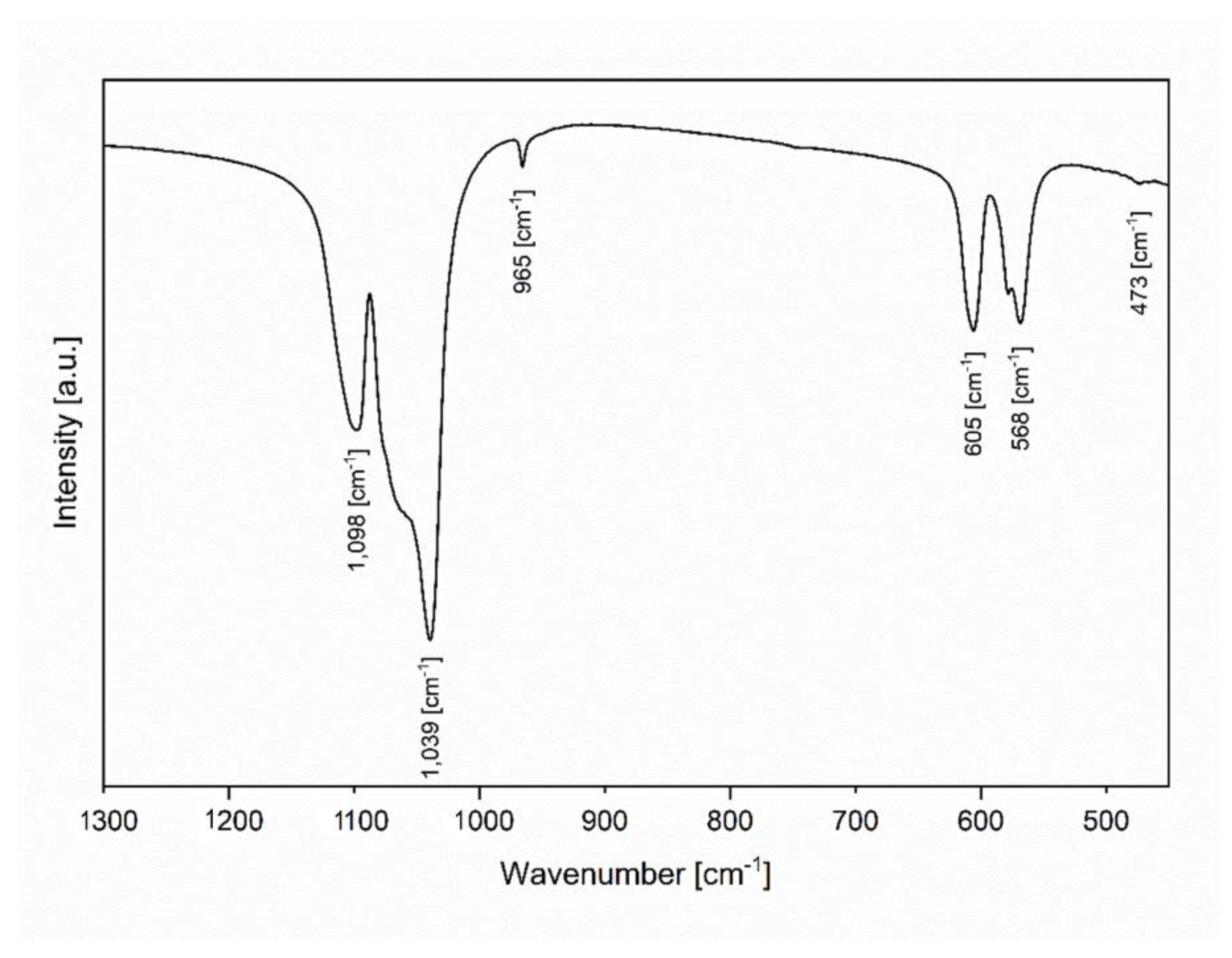
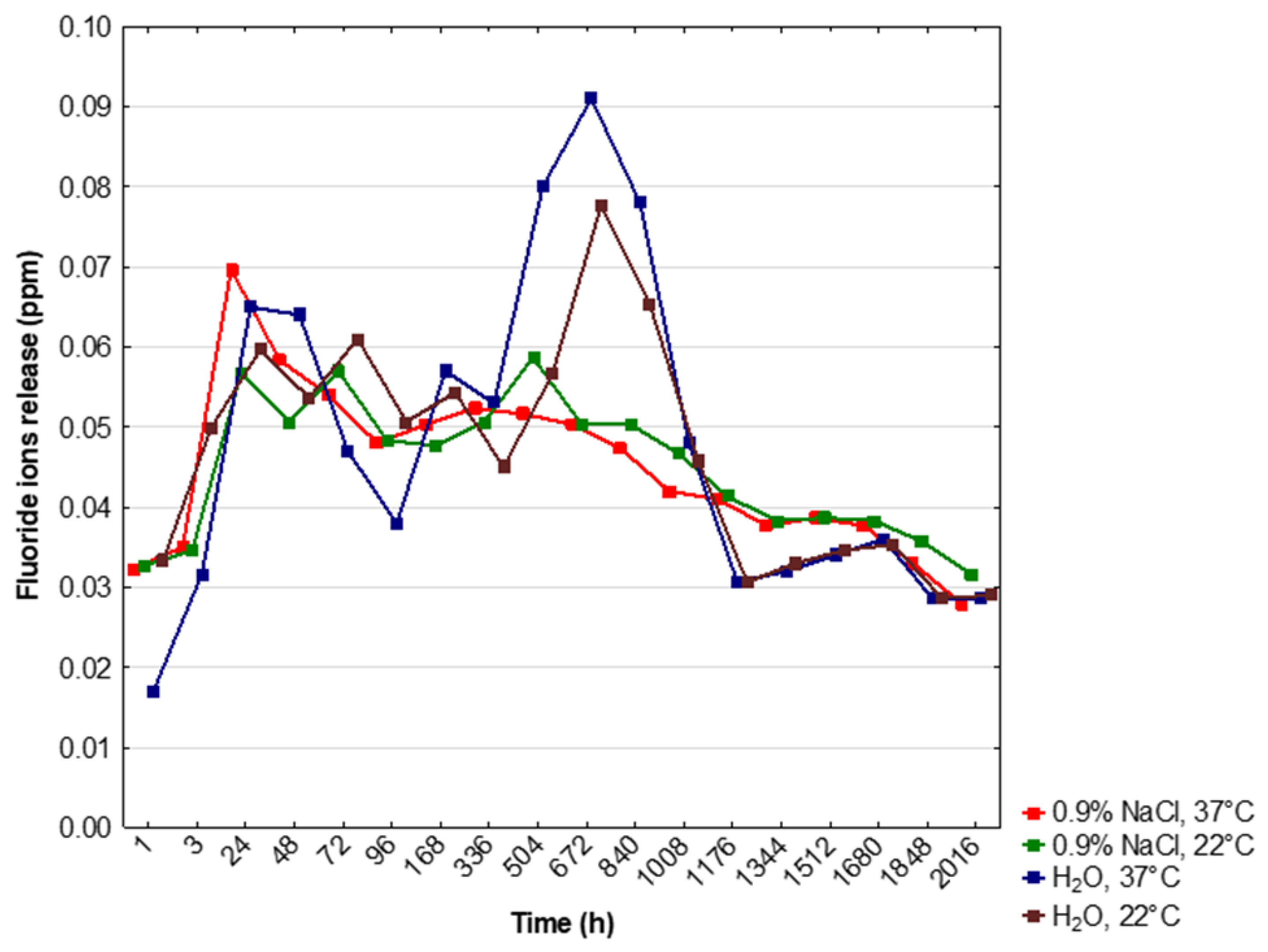
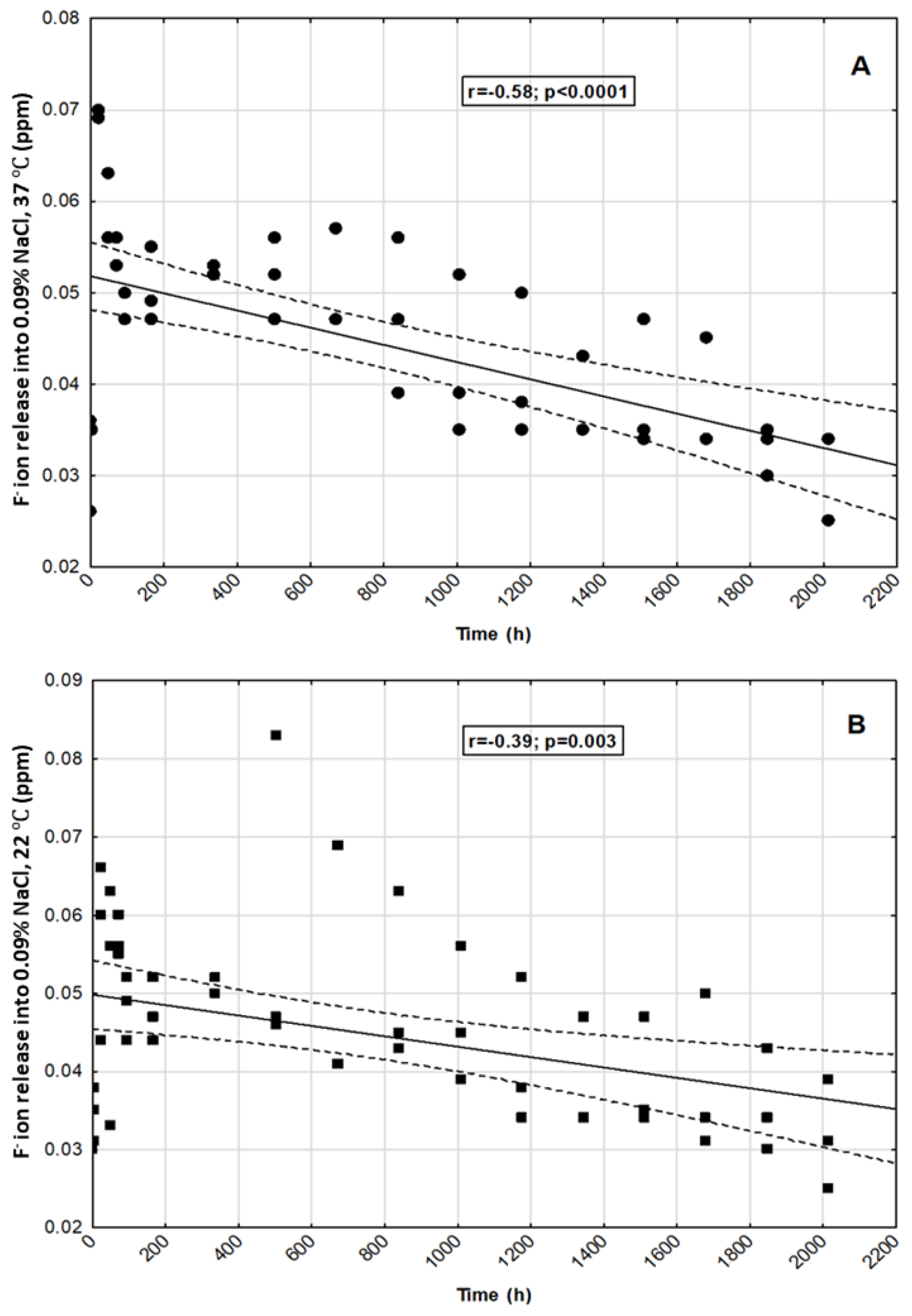
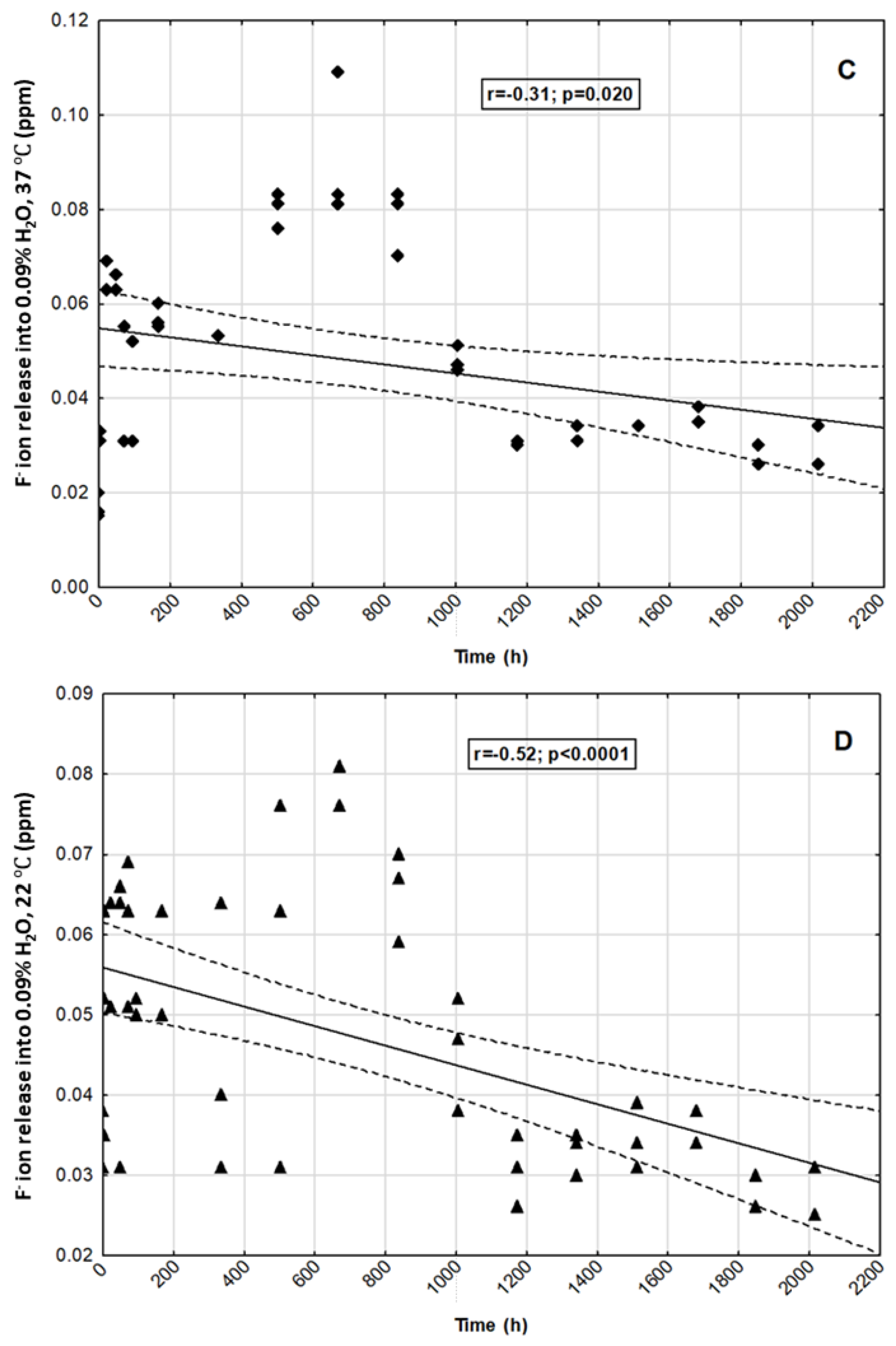
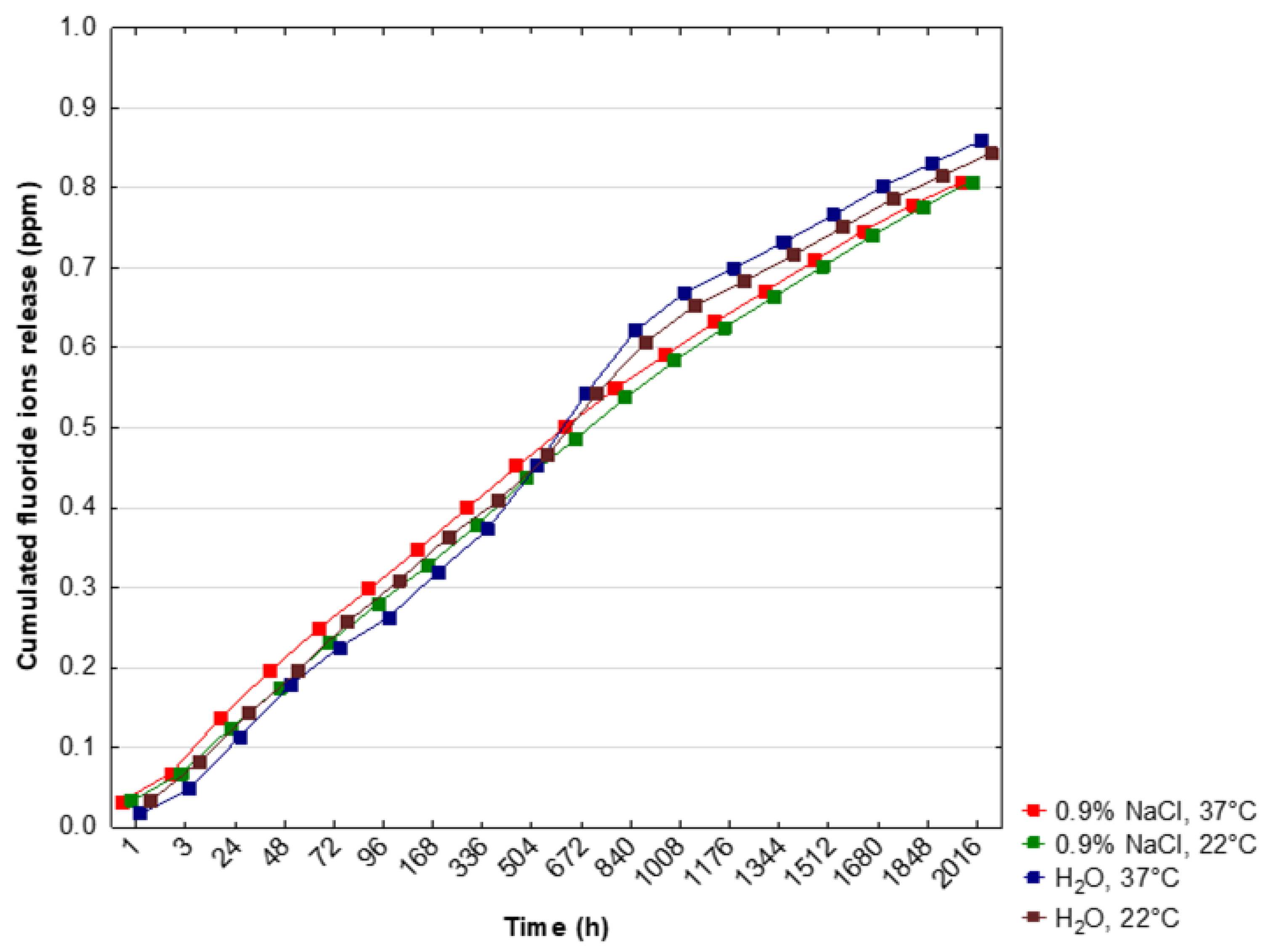
| Time (Hour) | Fluoride Concentration (ppm) | p-Value (ANOVA for Independent Groups) | |||
|---|---|---|---|---|---|
| 0.9% NaCl, 37 °C [A] | 0.9% NaCl, 22 °C [B] | H2O, 37 °C [C] | H2O, 22 °C [D] | ||
| 1 [1] | 0.0323 ± 0.0055 # | 0.0326 ± 0.0046 # | 0.0170 ± 0.0026 | 0.0333 ± 0.0040 # | 0.004 * |
| 3 [2] | 0.0350 ± 0.0000 3 | 0.0347 ± 0.0035 | 0.0316 ± 0. 0011 | 0.0500 ± 0.0141 | 0.057 |
| 24 [3] | 0.0697 ± 0.0006 1 | 0.0566 ± 0.0113 | 0.0650 ± 0.0034 1,2 | 0.0596 ± 0.0075 | 0.191 |
| 48 [4] | 0.0583 ± 0.0040 1 | 0.0506 ± 0.0156 | 0.0640 ± 0.0017 1,2 | 0.0536 ± 0.0196 | 0.619 |
| 72 [5] | 0.0540 ± 0.0017 | 0.0570 ± 0.0026 | 0.0470 ± 0.0138 1 | 0.0610 ± 0.0091 | 0.295 |
| 96 [6] | 0.0480 ± 0.0017 | 0.0483 ± 0.0040 | 0.0380 ± 0.0121 | 0.0506 ± 0.0011 | 0.157 |
| 168 (1 week) [7] | 0.0503 ± 0.0041 | 0.0476 ± 0.0040 | 0.0570 ± 0.0026 1 | 0.0543 ± 0.0075 | 0.175 |
| 336 (2 weeks) [8] | 0.0523 ± 0.0006 | 0.0506 ± 0.0011 | 0.0530 ± 0.0000 1 | 0.0450 ± 0.0170 | 0.667 |
| 504 (3 weeks) [9] | 0.0516 ± 0.0045 | 0.0586 ± 0.0210 | 0.0800 ± 0.0036 1,2 | 0.0566 ± 0.0231 | 0.215 |
| 672 (4 weeks) [10] | 0.0503 ± 0.0057 # | 0.0503 ± 0.0161 # | 0.0910 ± 0.0156 1,2 | 0.0776 ± 0.0028 | 0.005 * |
| 840 (5 weeks) [11] | 0.0473 ± 0.0085 # | 0.0503 ± 0.0110 # | 0.0780 ± 0.0070 1,2 | 0.0653 ± 0.0056 | 0.006 * |
| 1008 (6 weeks) [12] | 0.0420 ± 0.0088 3 | 0.0466 ± 0.0086 | 0.0480 ± 0.0026 1,9,10,11 | 0.0456 ± 0.0070 | 0.772 |
| 1176 (7 weeks) [13] | 0.0410 ± 0.0079 3 | 0.0413 ± 0.0094 | 0.0306 ± 0.0006 3,4,9,10,11 | 0.0306 ± 0.0045 10 | 0.129 |
| 1344 (8 weeks) [14] | 0.0376 ± 0.0046 3 | 0.0383 ± 0.0075 | 0.0320 ± 0.0017 3,4,9, 10,11 | 0.0330 ± 0.0026 | 0.308 |
| 1512 (9 weeks) [15] | 0.0386 ± 0.0072 3 | 0.0386 ± 0.0072 | 0.0340 ± 0.0000 3,4,9, 10,11 | 0.0346 ± 0.0040 | 0.616 |
| 1680 (10 weeks) [16] | 0.0376 ± 0.0063 3 | 0.0383 ± 0.0102 | 0.0360 ± 0.0017 9,10,11 | 0.0353 ± 0.0023 | 0.924 |
| 1848 (11 weeks) [17] | 0.0330 ± 0.0026 3,4 | 0.0356 ± 0.0066 | 0.0286 ± 0.0023 3,4,9,10,11 | 0.0286 ± 0.0023 10 | 0.154 |
| 2016 (12 weeks) [18] | 0.0280 ± 0.0052 3,4,8 | 0.0316 ± 0.0070 | 0.0286 ± 0.0046 3,4,9,10,11 | 0.0290 ± 0.0034 10 | 0.835 |
| p-value (ANOVA for dependent samples) | <0.0001 * | 0.0167 * | <0.0001 * | <0.0001 * | |
| Time (Hour) | Fluoride Concentration (ppm) | p-Value (ANOVA for Independent Groups) | |||
|---|---|---|---|---|---|
| 0.9% NaCl, 37 °C [A] | 0.9% NaCl, 22 °C [B] | H2O, 37 °C [C] | H2O, 22 °C [D] | ||
| 1 | 0.0323 + 0.0055 ### | 0.0326 ± 0.0046 ### | 0.0170 ± 0.0026 | 0.0333 ± 0.0040 ### | 0.004 * |
| 3 | 0.0673 ± 0.0055 ### | 0.0673 ± 0.0020 ### | 0.0486 ± 0.0037 | 0.0833 ± 0.0105 ### | 0.001 * |
| 24 | 0.1370 ± 0.0051 | 0.1240 ± 0.0115 | 0.1136 ± 0.0032 | 0.1430 ± 0.0173 | 0.041 |
| 48 | 0.1953 ± 0.0080 | 0.1746 ± 0.0270 | 0.1776 ± 0.0041 | 0.1966 ± 0.0366 | 0.557 |
| 72 | 0.2493 ± 0.0095 | 0.2316 ± 0.0247 | 0.2246 ± 0.0113 | 0.2576 ± 0.0457 | 0.457 |
| 96 | 0.2973 ± 0.0110 | 0.2800 ± 0.0288 | 0.2626 ± 0.0186 | 0.3083 ± 0.0465 | 0.314 |
| 168 (1 week) | 0.3476 ± 0.0145 | 0.3276 ± 0.0327 | 0.3196 ± 0.0185 | 0.3626 ± 0.0392 | 0.302 |
| 336 (2 weeks) | 0.4000 ± 0.0151 | 0.3783 ± 0.0336 | 0.3726 ± 0.0185 | 0.4076 ± 0.0221 | 0.276 |
| 504 (3 weeks) | 0.4516 ± 0.0185 | 0.4370 ± 0.0173 | 0.4526 ± 0.0170 | 0.4643 ± 0.0224 | 0.424 |
| 672 (4 weeks) | 0.5020 ± 0.0242 | 0.4873 ± 0.0159 | 0.5436 ± 0.0015 ## | 0.5420 ± 0.0020 ## | 0.011 * |
| 840 (5 weeks) | 0.5493 ± 0.0321 | 0.5376 ± 0.0234 | 0.6216 ± 0.0085 #, ## | 0.6073 ± 0.0261 ## | 0.006 * |
| 1008 (6 weeks) | 0.5913 ± 0.0410 | 0.5843 ± 0.0316 | 0.6696 ± 0.0100 | 0.6530 ± 0.0314 | 0.020 * post-hoc test: NS |
| 1176 (7 weeks) | 0.6323 ± 0.0352 | 0.6256 ± 0.0405 | 0.7003 ± 0.0100 | 0.6836 ± 0.0349 | 0.054 |
| 1344 (8 weeks) | 0.6700 ± 0.0398 | 0.0664 ± 0.0471 | 0.7323 ± 0.0102 | 0.7166 ± 0.0374 | 0.125 |
| 1512 (9 weeks) | 0.7086 ± 0.0370 | 0.7026 ± 0.0535 | 0.7663 ± 0.0102 | 0.7513 ± 0.0402 | 0.195 |
| 1680 (10 weeks) | 0.7463 ± 0.0433 | 0.7410 ± 0.0635 | 0.8023 ± 0.0107 | 0.7866 ± 0.0413 | 0.310 |
| 1848 (11 weeks) | 0.7793 ± 0.0453 | 0.7766 ± 0.0701 | 0.8310 ± 0.0101 | 0.8153 ± 0.0436 | 0.455 |
| 2016 (12 weeks) | 0.8073 ± 0.0505 | 0.8083 ± 0.0771 | 0.8596 ± 0.0118 | 0.8443 ± 0.0470 | 0.546 |
Publisher’s Note: MDPI stays neutral with regard to jurisdictional claims in published maps and institutional affiliations. |
© 2021 by the authors. Licensee MDPI, Basel, Switzerland. This article is an open access article distributed under the terms and conditions of the Creative Commons Attribution (CC BY) license (https://creativecommons.org/licenses/by/4.0/).
Share and Cite
Herman, K.; Wujczyk, M.; Dobrzynski, M.; Diakowska, D.; Wiglusz, K.; Wiglusz, R.J. In Vitro Assessment of Long-Term Fluoride Ion Release from Nanofluorapatite. Materials 2021, 14, 3747. https://doi.org/10.3390/ma14133747
Herman K, Wujczyk M, Dobrzynski M, Diakowska D, Wiglusz K, Wiglusz RJ. In Vitro Assessment of Long-Term Fluoride Ion Release from Nanofluorapatite. Materials. 2021; 14(13):3747. https://doi.org/10.3390/ma14133747
Chicago/Turabian StyleHerman, Katarzyna, Marta Wujczyk, Maciej Dobrzynski, Dorota Diakowska, Katarzyna Wiglusz, and Rafal J. Wiglusz. 2021. "In Vitro Assessment of Long-Term Fluoride Ion Release from Nanofluorapatite" Materials 14, no. 13: 3747. https://doi.org/10.3390/ma14133747
APA StyleHerman, K., Wujczyk, M., Dobrzynski, M., Diakowska, D., Wiglusz, K., & Wiglusz, R. J. (2021). In Vitro Assessment of Long-Term Fluoride Ion Release from Nanofluorapatite. Materials, 14(13), 3747. https://doi.org/10.3390/ma14133747








